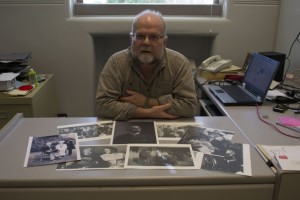When his mother died in late 2011, Camosun Digital Communications instructor Andy Bryce inherited a Pandora’s box of family memorabilia. As he was going through it all, one name kept coming up: Peter Henderson Bryce. Peter is Andy’s great-grandfather, and, until that point, Andy knew little about him.
“What I had known about him was he was a pioneer in public health in Canada,” says Bryce. “He had drafted the first public health legislation. We have clean drinking water and septic, and garbage collection and stuff that he originally set, along with his colleagues.”

As he searched the internet, Bryce—who has been teaching at Camosun for 18 years—quickly learned there was another story. His great-grandfather was the chief medical officer for the Department of Indian Affairs in 1907.
“He went out to the prairies to look at health conditions at residential schools in the prairies,” says Bryce. “He discovered that 24 percent of all students in all residential schools were dying of tuberculosis. Many more were infected by it and would probably be dead within a couple years of leaving the schools. This was the first time somebody, especially an official in the department, had so well documented what was going on in terms of health conditions in the residential schools. My great-grandfather, from that day on—from 1907 until probably the day he died—lobbied for better living conditions for indigenous people, which was a pretty unusual position to be taking at that time.”
This story of Peter’s time with the Department of Indian Affairs inspired Bryce to produce the documentary Finding Peter Bryce, which premiered on May 10 in Ottawa and is screening on Thursday, May 31 at Camosun.
“I have a news background and certainly had done lots of news documentaries, but I realized this was a very different animal from a news documentary. It’s an independent-point-of-view kind of documentary,” says Bryce.
Bryce enlisted his friend Peter Campbell to direct the documentary.
“He had done a film called Kuper Island: Return to the Healing Circle. It was one of the first films in the ’90s about residential schools, and the impact of these residential schools,” says Bryce.
They started the project in early 2015, completing it earlier this year—almost three years to the day later. The road to the finished product wasn’t without speed bumps, the biggest one being funding, as they decided to fund the project independently.
“We had to go out and find funding and, by far, that was the hardest part,” says Bryce. “But we had things happen. One person had a whole bunch of air miles so, one of the shoots we had to do was in Ottawa a couple years ago, and we got our flights paid for through her air miles. In that same shoot, we had someone pay for a rental vehicle for us through air miles… we had lots of stuff like that happen that made this possible.”
Thanks to extensive academic work on Peter Bryce over the past 20 years, the filmmakers were able to access information fairly easily.
“It was just a matter of going to Google and using different search terms to find that information,” says Bryce.
But that’s not to say their research was smooth sailing.
“One of the oddest things is that I went to the National Archives, took out his personnel file, and there was nothing in it from Indian Affairs,” says Bryce.
Despite the occasional hiccup, Bryce is happy with his tribute to his great grandfather. “In terms of the overall film that we created, and the goal that we wanted to reach, I think we’ve done exactly what we wanted to do.”
Finding Peter Bryce
7:30 pm Thursday, May 31
Free, Young 216, Camosun College Lansdowne campus
Search “Finding Peter Bryce” on Facebook for additional information
